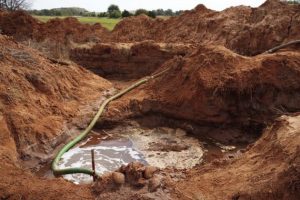
The Oklahoma Corporation Commission has vowed to “continue its operation” to collect and dispose of the saltwater discharging from a site in Caddo County for the past month “until such time as the flow stops,” agency spokesman Trey Davis told Southwest Ledger.
The saltwater “purge” was flowing Oct. 5 at a rate of approximately 56.02 barrels (2,352.84 gallons) per hour, or 1,416.48 barrels (59,492.16 gallons) per day, commission spokesman Trey Davis reported.
“It’s gone down in the last week,” commission oil and gas field inspector Carl Saucier told the Ledger on Oct. 8. The previous week’s discharge rate was 63 bph, or 1,512 bpd, Davis said. One barrel is equivalent to 42 gallons.
The saltwater is flowing from a site on land owned by Jim Ridgeway of Carnegie, according to Saucier. A trench and pit were excavated to divert the flow from Five Mile Creek, which feeds Cobb Creek and Fort Cobb Lake.
Consequently the purge poses “no current risk to the residents of Anadarko or Chickasha,” who get their drinking water from Fort Cobb Lake, Davis announced. Also, “there is no additional risk of contamination to area livestock or wildlife, as the flow is contained to the trench and pit.”
Five Mile Creek “has been brought back to beneficial use,” Saucier wrote in an Oct. 6 report.
The Corporation Commission has retained two tanker truck operators to collect the fluid and “haul it away to an authorized commercial disposal site” that Davis said is north of Hydro. It looks like we’re averaging about 11 to 13 truck tanks loads per day,” he said on Oct. 8.
“We’ll get ’er knocked out eventually,” Saucier said.
The Corporation Commission is “expending agency emergency funds” to contain the purge, Davis said.
Commission Chair Kim David sent a letter to Gov. Kevin Stitt on Sept. 24, advising him of a “serious environmental emergency and threat to public health and safety” from the Caddo County saltwater purge. The governor immediately authorized the agency to “employ the necessary service contractors to abate this environmental emergency and threat…” The Corporation Commission moved quickly to reduce the salt levels in Five Mile Creek, which was eyed as the culprit in the deaths of cattle in Caddo County last month.
Mike Loula of Colony told an Oklahoma City television station he lost 25 head of cattle – 23 cows and two calves – after they drank water from Five Mile Creek where it traverses property he owns near Eakly.
Loula reportedly had necropsies performed on two of his dead animals to determine the exact cause of their death. The Ledger has left three voice messages on Loula’s telephone – asking how much the cattle losses cost him and whether he has been informed of the precise cause of their deaths – but never received a response.
Saucier wrote that the Corporation Commission, which regulates the oil-and-gas industry in Oklahoma, was contacted Sept. 16 by Dillon Robbins of the state Department of Environmental Quality “to conduct a joint investigation concerning … dead livestock” thought to have been poisoned by contaminated water in Five Mile Creek.
Saltwater was discovered gushing into the creek two miles upstream from Loula’s property. The saltwater “tested over 130,000 parts per million (ppm) total dissolved solids,” Saucier reported.
Wells were shut in The OCC contacted two oil-and-gas operators nearest the purge “to shut in their gas wells” on Sept. 16.
Also that day the OCC contacted Nject, the operator of a commercial saltwater disposal well, and urged the company to shut in its well, “start operations to contain the saltwater purge from entering the creek, and begin removing fluids from the surface,” Saucier wrote.

State regulators began conducting field tests throughout Five Mile Creek, Cobb Creek, and Fort Cobb Lake on Sept. 17. The OCC collected samples for analysis of produced water from nearby leases and from the purge.
Nject dug a trench on the east side of the purge and diverted the saltwater away from the creek, Saucier wrote. Nject also started hauling saltwater from the trench and the creek.
“Fortunately, the flow into Five Mile Creek was quickly contained and the contaminated water was diverted,” Davis said.
The Corporation Commission began collecting water samples from Fort Cobb Lake on Sept. 18.
The agency also began collecting samples from water wells of “many concerned citizens along Five Mile Creek,” Saucier said. The level of total dissolved solids in the creek slowly declined throughout the week “as Nject has worked on removing saltwater from two deep pools found in the creek – one where the purge began and another four miles south of it.”
The owner of the saltwater disposal well was informed Sept. 19 that the Corporation Commission would “seal and red-tag” his well “until the OCC’s investigation is concluded.”
The agency also resumed collecting water samples from nearby water wells along Five Mile Creek that day. Total dissolved solids readings in the creek ranged from 900 ppm to 1,600 ppm downstream. The pool under the first bridge where the purge began ranged from 18,000 ppm to 27,000 ppm.
The Corporation Commission on Sept. 22 recommended Nject Disposal LLC continue to remove saltwater from the pool in the creek “until it is back to permissible limits, and keep the trench emptied until the purge stops or the source is identified.”
“Our tests indicate the total dissolved solids levels in Five Mile Creek, Cobb Creek, and Fort Cobb Lake are no longer affected” by the purge, Davis said.
The Corporation Commission will continue its investigation through the agency’s affected departments – Field Operations, Underground Injection Control, Pollution Abatement, Technical, and Legal – “to identify the source causing the purge and to determine the responsible party,” Saucier wrote last week.
He also said the agency plans “to update this incident by Oct. 28.”
The Corporation Commission is “the jurisdictional agency” in this investigation, but the Department of Environmental Quality is “providing support,” DEQ spokesperson Skylar McElhaney told the Ledger.

